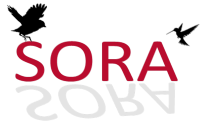Fall Notes from Haywards, California
Fall Notes from Haywards, Cal.
On October 30, 1898 I noticed for the first time in this locality the Western Nighthawk (C. virginianus henryi.) It was flying southward high in air just after sun-down in long zigzag sweeping circles, no doubt feeding as it flew to a more inviting winter home. In nineteen years' observation at Haywards this is my first record of the Nighthawk. I am told they are common on the east side of the range in the San Joaquin valley. At Poway, San Diego Co., they occur commonly as spring migrants.
RED BREASTED NUTHATCH. (Sitta canadensis.) These Nuthatches made their appearance in scattering pairs among the blue gum trees, live oaks and almond trees. In the latter they seemed to find abundant food as I noted them busy picking into the nuts on September 3, 1898. They were common in the gum trees about the Oakland hills and in Marin Co., where I am told they were seen in large bands. This is their first appearance at Haywards since October 24, 1882.
WESTERN GOLDEN-CROWNED KINGLET. (Regulus satrapa olivaceus.) Observed feeding among the willows back of Oakland on October 22, 1898. Have not been noticed about Haywards since October 16, 1884.
TOWNSEND'S SPARROW. (P. iliaca unalaschcensis.) Have been unusually common this fall, coming into the gardens about the house and hedges but generally shy and keeping to the thick brush of the creek banks and canon sides. The earliest arrival in ten years' observations is for this season, September 25, 1898.
RED-BREASTED SAPSUCKER. (Sphyrapicus ruber.) Have seen an unusual number of this alpine species, a number having taken a fancy to a big blue gum (eucalyptus) tree in the yard, where, on warm sunny days, they would go to peck holes and suck the rich sap that flows freely in the cold fall months. One I found in a willow tree trying to get the best of a yellow jacket's nest, dodging back and forth either to get a mouthful of their stored sweets or the jackets themselves. Most of the fall birds have a darker colored breast than the spring plumaged birds which are bright scarlet. They arrive at Haywards in October and November and again in March on their way to the high Sierras.
MOUNTAIN SONG SPARROW. (Melospiza fasciata montana.) A pair of these Sparrows I took on December 16, 1897 among the dead bull rushes on the edge of a salt marsh below Haywards, forming a new county record. They are a form of Melospiza easily overlooked by most collectors, as also is M. fasciata guttata. The latter have been seen several times this winter. My records for Haywards have been March 10, 1880, November 23, 1882, October 28, 1883, January 18, 1888 and October 13, 1898.
W. OTTO EMERSON
Haywards, Cal. Dec. 9, 1898.

